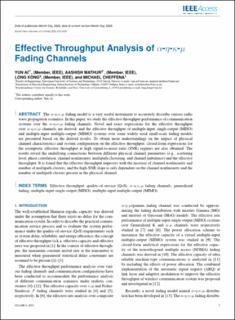| dc.contributor.author | Ai, Yun | |
| dc.contributor.author | Mathur, Aashish | |
| dc.contributor.author | Kong, Long | |
| dc.contributor.author | Cheffena, Michael | |
| dc.date.accessioned | 2020-03-23T13:13:46Z | |
| dc.date.available | 2020-03-23T13:13:46Z | |
| dc.date.created | 2020-03-21T13:16:17Z | |
| dc.date.issued | 2020 | |
| dc.identifier.citation | IEEE Access. 2020, . | en_US |
| dc.identifier.issn | 2169-3536 | |
| dc.identifier.uri | https://hdl.handle.net/11250/2648157 | |
| dc.description.abstract | The α-η-κ-μ fading model is a very useful instrument to accurately describe various radio wave propagation scenarios. In this paper, we study the effective throughput performance of communication systems over the α-η-κ-μ fading channels. Novel and exact expressions for the effective throughput over α-η-κ-μ channels are derived, and the effective throughput of multiple-input single-output (MISO) and multiple-input multiple-output (MIMO) systems over some widely used small-scale fading models are presented based on the derived results. To obtain more understandings on the impact of physical channel characteristics and system configuration on the effective throughput, closed-form expressions for the asymptotic effective throughput at high signal-to-noise ratio (SNR) regimes are also obtained. The results reveal the underlying connections between different physical channel parameters (e.g., scattering level, phase correlation, channel nonlinearity, multipath clustering, and channel imbalance) and the effective throughput. It is found that the effective throughput improves with the increase of channel nonlinearity and number of multipath clusters, and the high-SNR slope is only dependent on the channel nonlinearity and the number of multipath clusters present in the physical channel. | en_US |
| dc.language.iso | eng | en_US |
| dc.publisher | IEEE | en_US |
| dc.relation.uri | https://ieeexplore.ieee.org/stamp/stamp.jsp?tp=&arnumber=9043564 | |
| dc.rights | Navngivelse 4.0 Internasjonal | * |
| dc.rights.uri | http://creativecommons.org/licenses/by/4.0/deed.no | * |
| dc.title | Effective Throughput Analysis of α-η-κ-µ Fading Channels | en_US |
| dc.type | Peer reviewed | en_US |
| dc.type | Journal article | en_US |
| dc.description.version | acceptedVersion | en_US |
| dc.source.pagenumber | 9 | en_US |
| dc.source.journal | IEEE Access | en_US |
| dc.identifier.doi | 10.1109/ACCESS.2020.2982279 | |
| dc.identifier.cristin | 1802773 | |
| dc.description.localcode | This work is licensed under a Creative Commons Attribution 4.0 License. For more information, see https://creativecommons.org/licenses/by/4.0/. First published 20.03.2020 | en_US |
| cristin.ispublished | true | |
| cristin.fulltext | postprint | |
| cristin.qualitycode | 1 | |

